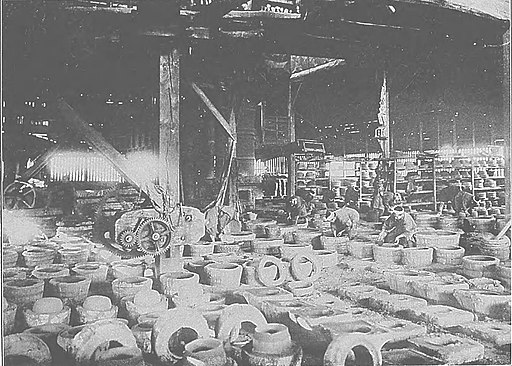Discovering Japanese Cast Iron Kettles - Characteristics and Production Areas of Tetsubin
In Japan, a plethora of diverse tetsubin types can be found. Currently, tetsubin production is not limited to our location in Iwate Prefecture (known for Nambu Ironware). The creation of tetsubin has expanded to Yamagata Prefecture, another region within Tohoku, as well as to Kyoto, Tochigi, Toyama, and various other regions across Japan, albeit in smaller quantities.
Our intention is to present a comprehensive overview of the historical significance and distinguishing features associated with these principal tetsubin manufacturing regions in Japan.
Nambu Tetsubin - Nambu Ironware (Tekki) Iwate Pref.

History of Nambu Ironware
Nambu ironware is a traditional craft from Iwate Prefecture in Japan's Tohoku region, near Morioka City and Oshu City. Its roots trace back to the 17th century when the Nanbu family invited a Kyoto craftsman to create tea kettles. Oshu City's ironware history dates to the 12th century, with artisans from Shiga Prefecture crafting daily items, ornaments, and Buddhist objects for Chuson-ji Temple.
The Nanbu tetsubin, as it is known today, emerged around 1750 with the popularity of sencha green tea. This led to the addition of a spout and handle to the traditional tea kettle, making it more practical for boiling water. The tetsubin has gained global recognition for its ability to enhance water quality and improve tea flavor.
Characteristics of Nanbu Tetsubin
The Nambu tetsubin embodies an iron kettle of dignified and rustic ambiance. Predominantly, the lid and handle are fashioned from iron, while the quintessential Arare pattern (characterized by concave-convex dots) has become emblematic of Japanese tetsubin. Over its surface, a layer of Japanese lacquer is meticulously applied, not only furnishing an anti-rust property but also affording users the pleasure of admiring the profound hue of the iron patina. Contemporary trends reflect a surge in popularity for voguish silhouettes and vibrant shades that harmonize with modern lifestyles.
Yamagata Tetsubin - Yamagata Metal Casting - Yamagata Pref.
History of Yamagata Metal Casting
During the mid-11th century, Minamoto no Yoriyoshi (源 頼義, 988 - 1075), a Kansai-rooted warlord, undertook a series of campaigns in Yamagata. His aim was to quell potent clans within the Tohoku region that defied the Imperial Court's directives. It is recounted that the inception of the Yamagata Metal Casting Industry transpired when a warrior-craftsman, amidst the conflict, serendipitously stumbled upon the riverbed sands (Umamigasaki River) of Yamagata City as an excellent medium for casting, leading to his settlement there. Initially focused on producing everyday essentials and Buddhist altar implements, the post-Meiji era (late 19th century) witnessed a diversification into artisanal crafts like iron kettles and tea kettles.
Characteristics of Yamagata Tetsubin
The Yamagata tetsubin garners admiration for its slender, intricate design and meticulous proportions, likely attributed to its origins in a foundry that originally specialized in crafting lightweight armor. In contemporary times, a plethora of industrial and modern designs have emerged as well.
Kyo Tetsubin - Kyoto (Kansai region)
History of Kyoto Metal Casting
In Kyoto, a casting enclave centered around Sanjo-Kamaza has flourished since antiquity. Reports indicate that as early as the 12th century, numerous metal artisans congregated in this locale. Renowned for crafting "Kyo-gama (Kyoto style)" tea ceremony kettles, two enduring lineages, the Onishi Family and Takagi Family, continue to thrive within this precinct.
In addition to these iconic tea ceremony kettles, Ryubundo (龍文堂) pioneered tetsubin production in Kyoto circa 1764, employing a wax casting technique. The second generation of Ryubundo's apprentices included master craftsmen from Omi (Shiga Prefecture), notably Kibundo (亀文堂) and Hata Zoroku (秦蔵六), who achieved prominence beyond Kyoto and are acknowledged as Kansai tetsubin artisans. Regrettably, both Ryubundo and Kibundo have ceased operations. Presently, homage pieces referred to as "Utsushi (hommage)" continue to be crafted in Takaoka metal casting, following the same wax mold methodology.
Characteristics of Kyo Tetsubin
Diverging from Nambu tetsubin, the lid of Kyo tetsubin is forged from copper. Frequently fashioned through wax casting, their hallmark lies in the velvety texture and intricate three-dimensional contours. Gilded and silvered embellishments, coupled with intricate engravings, bestow these tetsubin with an opulent, distinctly Kyoto-esque allure. Within the inner base of the tetsubin, "narikane" (鳴金), iron pieces coated in Japanese lacquer, occasionally emit resonant sounds akin to bubbles when water is boiled.
Tenmyo Tetsubin - Tenmyo Metal Casting - Tochigi Pref.

History of Tenmyo Metal Casting
The legacy of Tenmyo metal casting is believed to trace its origins to the mid-10th century, during the tenure of Fujiwara no Hidesato (藤原 秀郷, 891 - 958). Commissioned by the Imperial Court to govern the region, he beckoned five artisans from the southern precincts of present-day Osaka. This consortium migrated to the vicinity around Sano City, embarking on the craft of weapon casting. The tide of tea ceremony kettle production surged from the mid-15th century onward, adorning a simplistic style that found favor among tea masters. Historical records attest that Sen no Rikyū (千利休, 1522 – 1591), a prime exponent of the tea ceremony's zenith, orchestrated a tea ceremony featuring a Tenmyo tea ceremony kettle. Among extant artifacts, the oldest Tenmei tea ceremony kettle is the "Gokurakuritsuji Mei Odare-gama (重要文化財 鉄 天命 極楽律寺 銘尾垂釜 1352)," housed within the collection of the Osaka City Museum of Art.
Characteristics of Tenmei Tetsubin
Tenmei tetsubin are distinguished by their innate simplicity, echoing the lineage of Tenmei tea ceremony kettles. Their appearance exudes a wabi-like essence, capturing the rugged texture of iron.
Takaoka Tetsubin - Takaoka Metal Casting - Toyama Pref.

History of Takaoka Metal Casting
In the early 15th century, Maeda Toshinaga (前田 利長, 1562 – 1614), a feudal lord governing this realm, extended an invitation to seven artisans hailing from the Kanaya region. This endeavor was undertaken to safeguard these craftsmen within the confines of his castle. Subsequently, their focus evolved beyond iron castings, encompassing the creation of copper articles including bells, lanterns, and intricately embellished everyday items like flower vases.
Characteristics of Takaoka Tetsubin
A hallmark of Takaoka tetsubin resides in their intricate, dynamic, and multi-dimensional castings achieved through the meticulous process of wax casting. Gold and silver inlays, accompanied by skillful engraving, harmonize with metal craftsmanship such as copper lids and silver adornments, culminating in resplendent ornamentation.
Conclusion
Japanese tetsubin exhibit a vast spectrum of styles, ranging from understated simplicity to opulent grandeur. While certain traits have been outlined here, it's important to note that each atelier and artisan possesses a distinct style and artistic vision. We trust that among this diversity, you will discover a piece that resonates with your preferences. However, we urge you to exercise caution and make purchases from reputable retailers, as some prominent online marketplaces may erroneously present non-Japanese items as "handmade in Japan."
We proudly introduce ourselves as Oitomi, a Nambu ironware studio with a heritage tracing back to 1848. Residing in Iwate Prefecture, Japan, for eight successive generations, our artisans meticulously create authentic tetsubin. Our range encompasses traditional tetsubin designs as well as an array of contemporary colors and forms, thoughtfully tailored to modern kitchens. We extend our offerings directly from Japan to destinations across the globe, ensuring an authentic and genuine experience.
Nambu Ironware Studio Oitomi Online Shop - Direct from Japan
Reference:
南部鉄器 岩手県 https://www.pref.iwate.jp/kensei/profile/1000655/1021500.html
山形鋳物 山形県 https://www.pref.yamagata.jp/020026/kensei/shoukai/yamagatamonogatari/sangyou/imono.html
佐野天明鋳物 栃木県教育委員会 https://www.tochigi-edu.ed.jp/furusato/detail.jsp?p=61&r=300
天明鋳物 栃木県 https://www.pref.tochigi.lg.jp/culture/bunkajoho/tsushin/sano.html
京都の三条釜座 国立国会図書館 https://crd.ndl.go.jp/reference/modules/d3ndlcrdentry/index.php?page=ref_view&id=1000052431
『角川茶道大事典 本編』(林屋 辰三郎/[ほか]編集 角川書店)p574[三条釜座]
『国史大辞典 3』(国史大辞典編集委員会/編 吉川弘文館)p562[かまんざ 釜座]
近世三条佂座鋳物師の実態について 田中聡 https://www.ritsumei.ac.jp/acd/cg/lt/rb/672/672PDF/tanaka.pdf
鉄瓶 文化遺産オンライン https://bunka.nii.ac.jp/heritages/detail/517787
鋳物資料館 TAKAOKA City https://www.city.takaoka.toyama.jp/bunkazai/kanko/bunka/shisetsu/imono.html
前田利長書状 高岡市立博物館 https://www.e-tmm.info/syuuzou/nisibu.htm
 Skip to content
Skip to content
